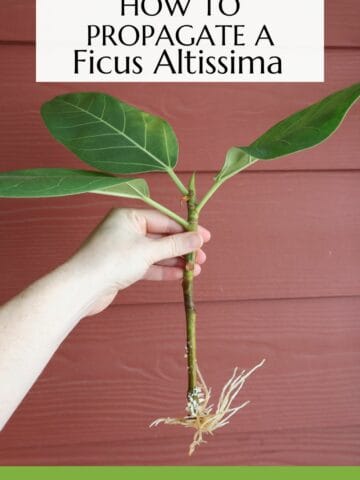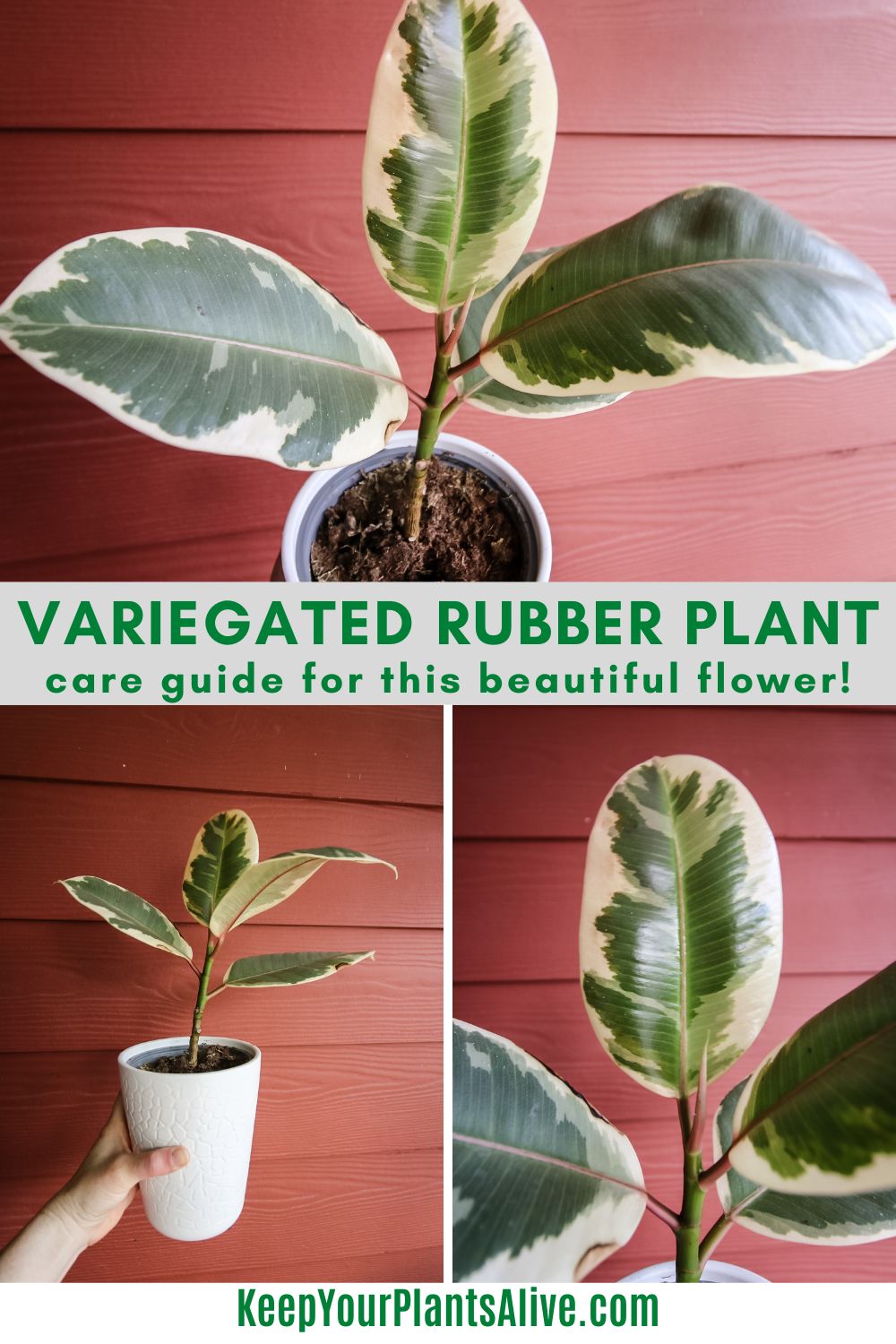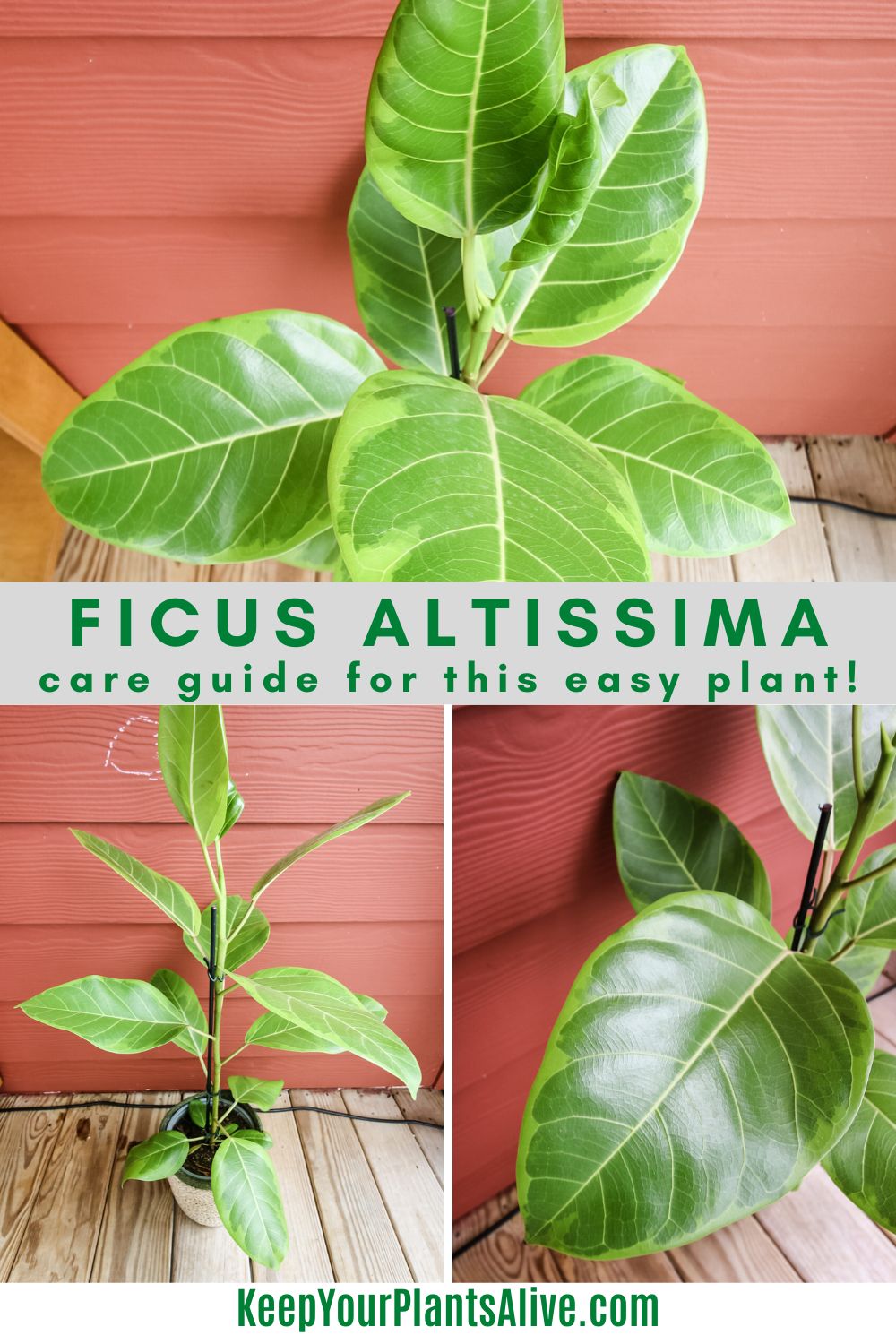Want to add a Ficus burgundy rubber plant to your houseplant collection? They are beautiful and easy to care for! Here's my complete Ficus burgundy rubber plant care guide!
I was recently looking for a plant to put in the corner of our home office. I wanted something that would do OK with medium light - this corner is 3 feet from a window but next to it, not in the direct light. It's also under these 3 little windows up high on the wall. So, lots of indirect light, but nothing super bright.
I have a soft spot for black houseplants. They are just so unexpected and interesting. I love my Raven ZZ and my Dark Mystery pilea.
So, I was excited to grab a burgundy rubber tree for the space. It does well in medium to bright light, will grow tall quickly, and adds an unexpected pop of color to my space!

What is Ficus burgundy rubber plant?
Rubber plants are a super popular and common houseplant. The burgundy rubber plant is slightly different in coloration from your typical rubber plant.
I was very attracted to the burgundy rubber plant because of it's dark green - almost black - leaves with pink along the new growth and on the stem.
Other names for Ficus burgundy rubber plant include:
- Ficus Elastica Burgundy
- Burgundy Rubber Tree
- Indian Rubber Tree
- Red rubber plant
- Ficus Decora Burgundy
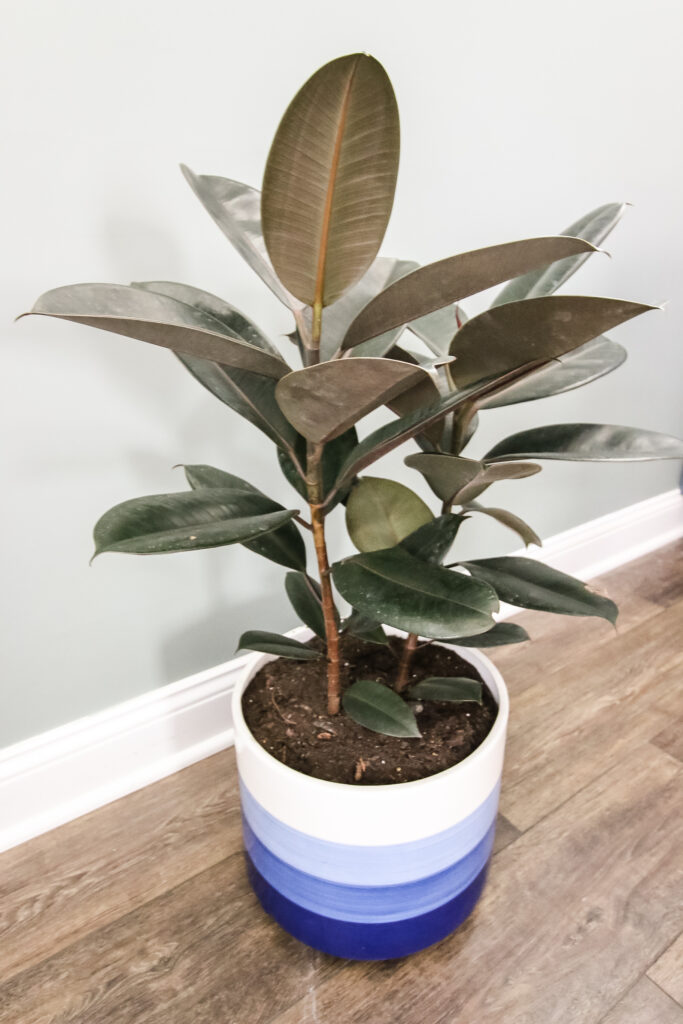
Ficus burgundy rubber plant origins
This plant is native from the Himalayas to Malaysia, Sumatra and Java.
Is Ficus burgundy rubber plant rare?
I got my burgundy rubber plant at Home Depot. I consider anything at Home Depot to be not-rare 🙂
However, its coloration does make it a unique and interesting addition to your houseplant collection!
Is Ficus burgundy rubber plant toxic?
The sap of a rubber plant contains latex (hence the name "rubber" plant) and is poisonous to both pets and children.
Theoretically, a healthy plant won't be an issue, but if an animal or person snapped a leaf or stem, the sap would be exposed. I suggest you keep these plants away from kids and pets!
Do Burgundy rubber plants grow fast?
These plants are relatively fast growing plants! Because of that, they. usually need to be repotted into a larger pot every spring!
How big do Burgundy rubber plants get?
These plants can grow up to 40 feet tall with 12" long leaves when planted outdoors in their native environment! As potted plants, they tend to max out around 10 feet tall.
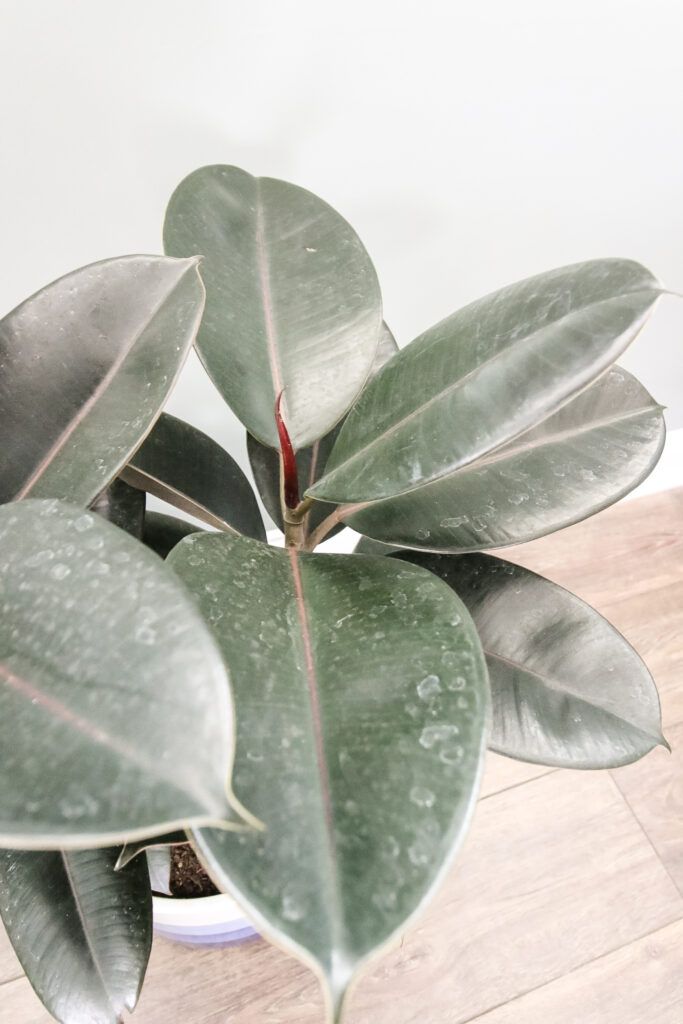
Ficus burgundy rubber plant care guide
This variety of the rubber plant is unique looking and easy to care for!
Ficus burgundy rubber plant watering
Water your rubber plant when the top 2 inches of soil feel dry to the touch. This will be more often if your plant gets more light or is kept in warmer conditions, which dries the soil out quicker.
Read my guide on drilling drainage holes in pots!
Try to avoid splashing or spraying water right on the leaves of your rubber plant. This will often lead to white water spots on the dark leaves! They can be easily cleaned off if needed.
How often should I water my Ficus burgundy rubber plant?
Water your rubber plant when the top 2 inches of soil feel dry to the touch - this is usually once a week, but could be more often or less often depending on your plant's conditions.
Should I mist my Ficus burgundy rubber plant?
Rubber plants are native to humid areas, so they like humidity in your home. You can mist them, add a pebble tray, or run a humidifier if your home has dry air.

Ficus burgundy rubber plant lighting needs
Rubber plants do best in bright, indirect light. They can also do well in medium light, but they will grow at a slower rate with less light.
Be careful to keep them out of direct sunlight, which can scorch their leaves.
Can I keep Ficus burgundy rubber plant outdoors?
Rubber plants are Winter hardy to USDA Zones 10-12. Outside of those zones, you will need to bring them indoors in the winter - especially when temperatures drop below 50 degrees.
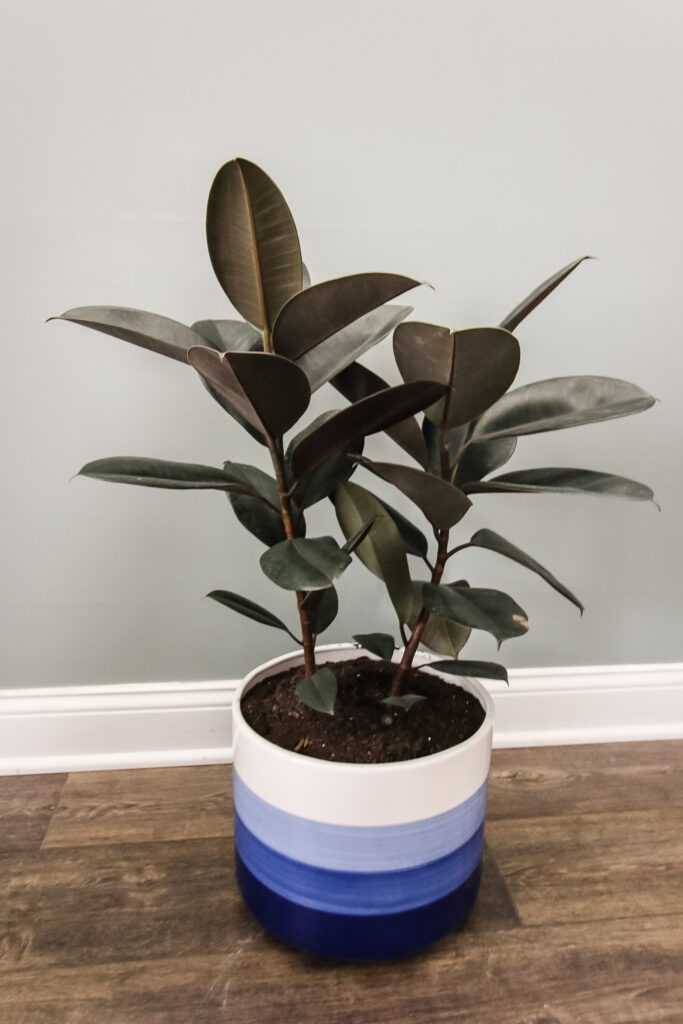
Ficus burgundy rubber plant soil + potting
Ficus Burgundy rubber plants prefer well-draining soil that's rich in organic matter. A mixture of potting soil, perlite, and peat moss can work well.
The most important thing is that your pot have drainage holes to keep your plant's roots from getting soggy.
Does Ficus burgundy rubber plant like to be root bound?
Rubber plants in general do not mind a tight pot and are OK to be a little root bound. However, if you notice that your plant's growth rate has slowed down, consider pulling it out of the pot.
If it's very root bound, it would likely benefit from moving up to a pot that is 1-2 inches larger in diameter.
Repotting Burgundy Rubber plants
Ficus Burgundy rubber plants should be repotted every 2-3 years, or when they outgrow their current pot. Use a slightly larger pot (1-2" wider in diameter) with fresh potting soil.
Sometimes these plants get upset when they are moved, and it's not uncommon for them to drop leaves or look a bit sad after a repotting. It should perk bak up in 2-3 weeks.
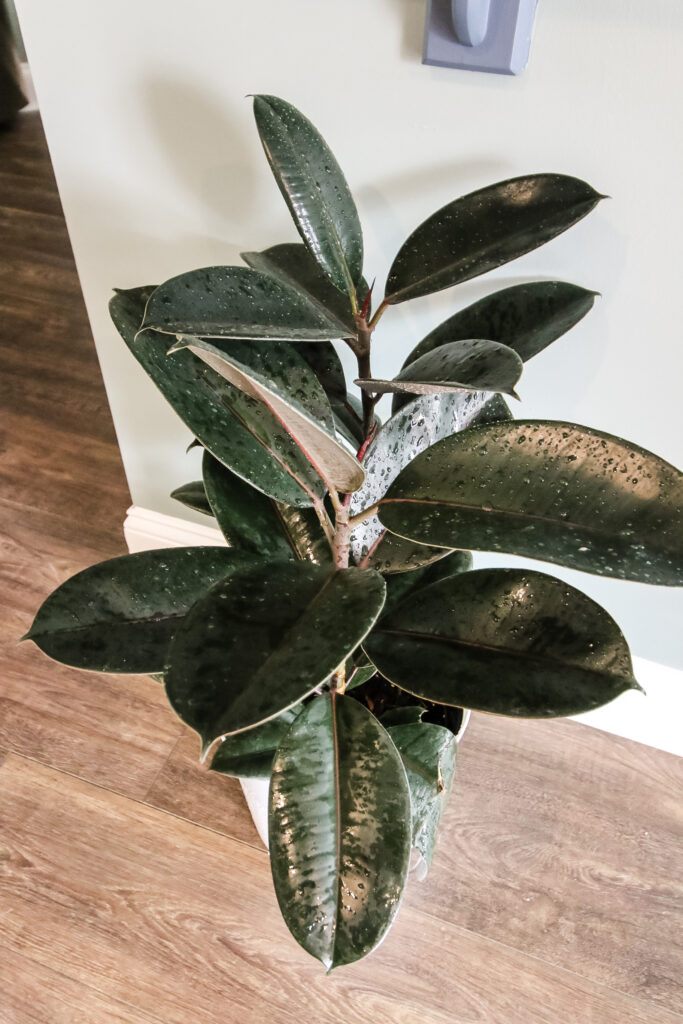
Pruning Ficus Burgundy Rubber Plant
Ficus Burgundy rubber plants can grow quite tall, so pruning can help maintain their shape and size.
You can pinch back the tips of the plant to encourage bushier growth, or trim off any leggy or damaged branches.
Healthy cuttings can be propagated in water or soil to create new plants!
Ficus burgundy rubber plant fertilization
You can fertilize your rubber plant once a month during warm growing season. Use any general houseplant fertilizer!
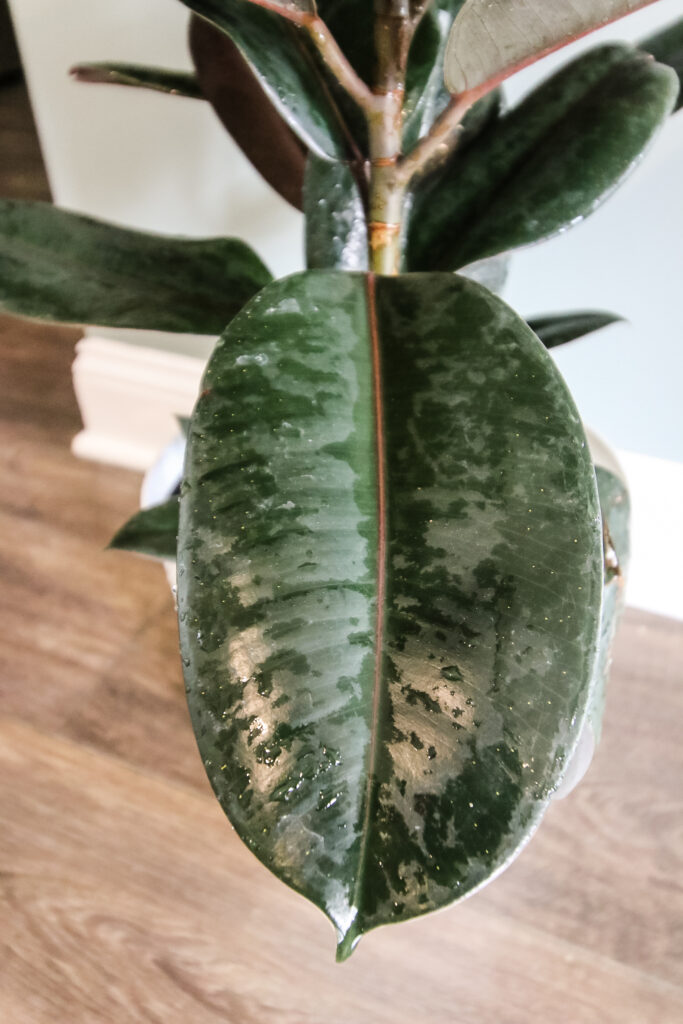
How to propagate Ficus burgundy rubber plant
It is extremely easy to propagate Ficus burgundy rubber plant in water.
- Identify a healthy branch, preferably with new growth
- Snip the branch with sharp scissors
- Remove any lower leaves
- Place in water so at least 1 - preferably 2 - nodes are underwater
- Change the water once a week and top off as necessary
- See roots form in 2-4 weeks
- Once the roots are 2-3 inches long, plant in soil

Troubleshooting Ficus burgundy rubber plant
How do I clean my rubber plant?
Rubber plant leaves get dusty easily. I recommend using a soft, damp cloth to clean them. Here's my complete guide to cleaning plant leaves!
Why is my rubber plant not burgundy?
These plants will lose their dark coloring if they aren't getting enough light. If your plant is turning a bit green, try moving it to a brighter spot!
Do rubber plants get a lot of pests?
Ficus Burgundy rubber plants are relatively pest and disease resistant, but they can be susceptible to mealybugs, spider mites, and scale insects.
Keep an eye out for any signs of infestation, such as webbing, sticky residue, or yellowing leaves. Treat infestations promptly with insecticidal soap or neem oil.
Why is my rubber plant dropping leaves?
Leaf drop is a sign that your plant is in distress. But, this means that you have a chance to fix it! You need to identify the issue and reverse it to stop the leaf drop.
Click here for our complete guide to rubber plant leaf drop!
Ficus burgundy rubber plant free printable care guide
Join the (free!) KeepYourPlantsAlive+ community to access this exclusive printable plant care guide! Once you sign up, you can right click & save the JPG care guide. Or keep scrolling for more!
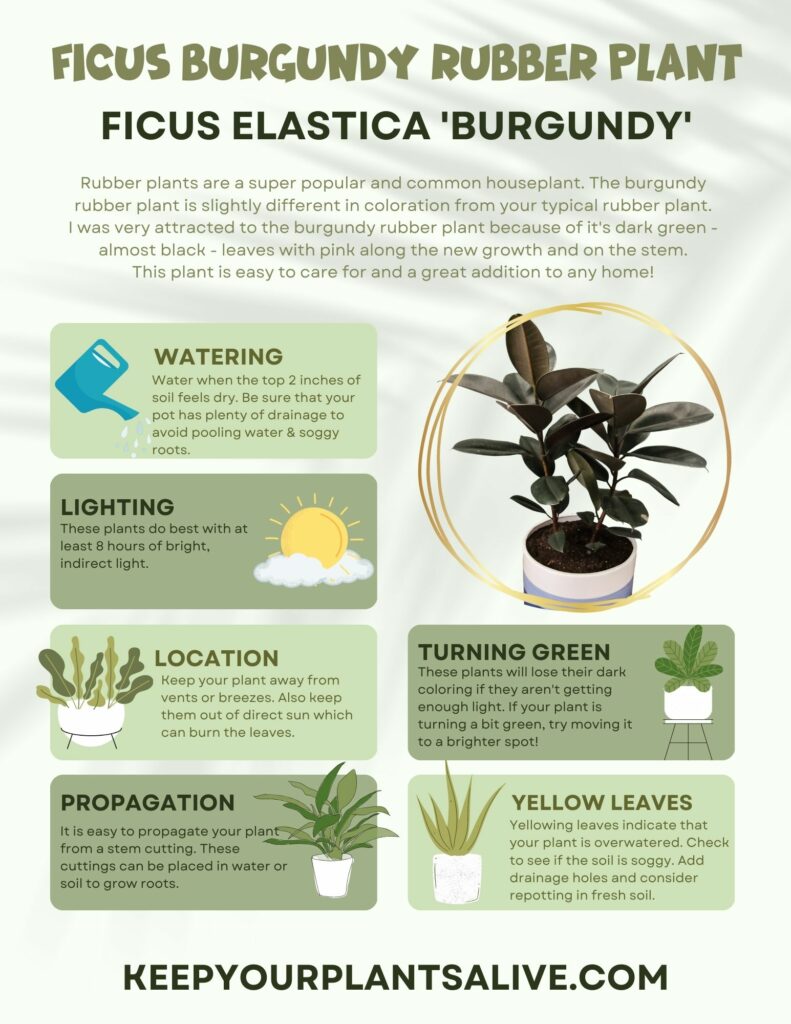
Thanks for reading!


Hey there, I'm Morgan, a houseplant enthusiast from sunny Charleston, South Carolina. Growing up surrounded by my mom's lush orchids and African violets, I discovered the magic of bringing nature indoors. Thanks to the pandemic, I delved deeper into houseplants, discovering their power to uplift moods and transform spaces. I'm here to spill all my secrets, helping you pick the perfect houseplant - and make it happy. Let's keep your plants alive, together! 😊

